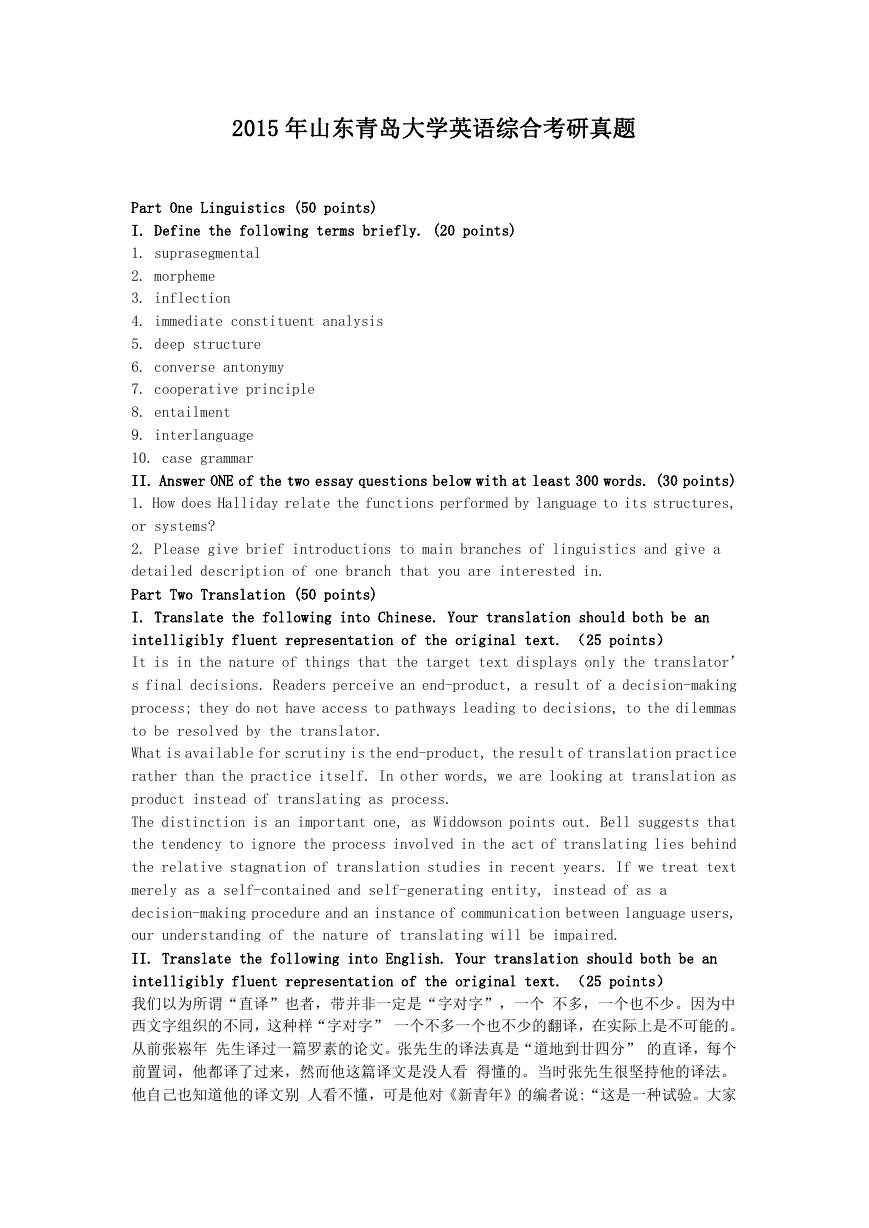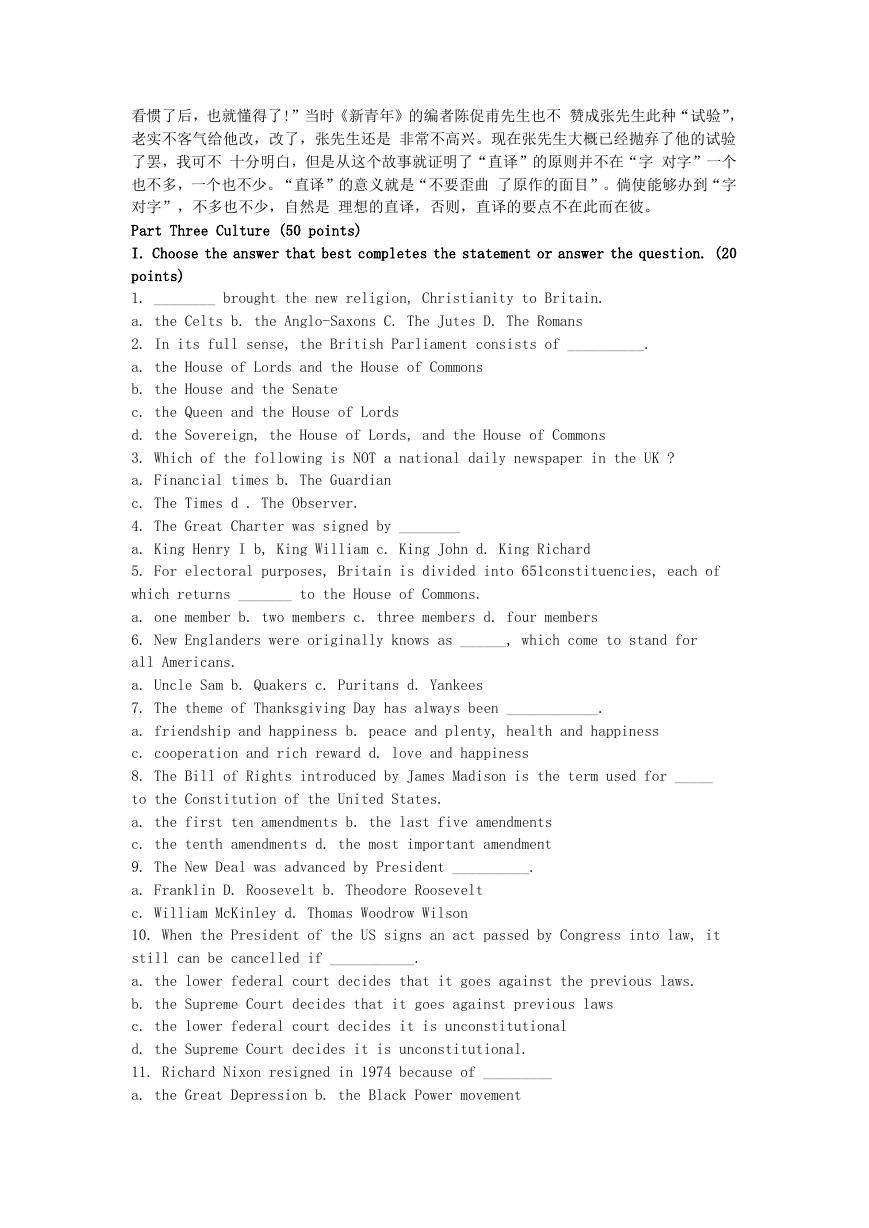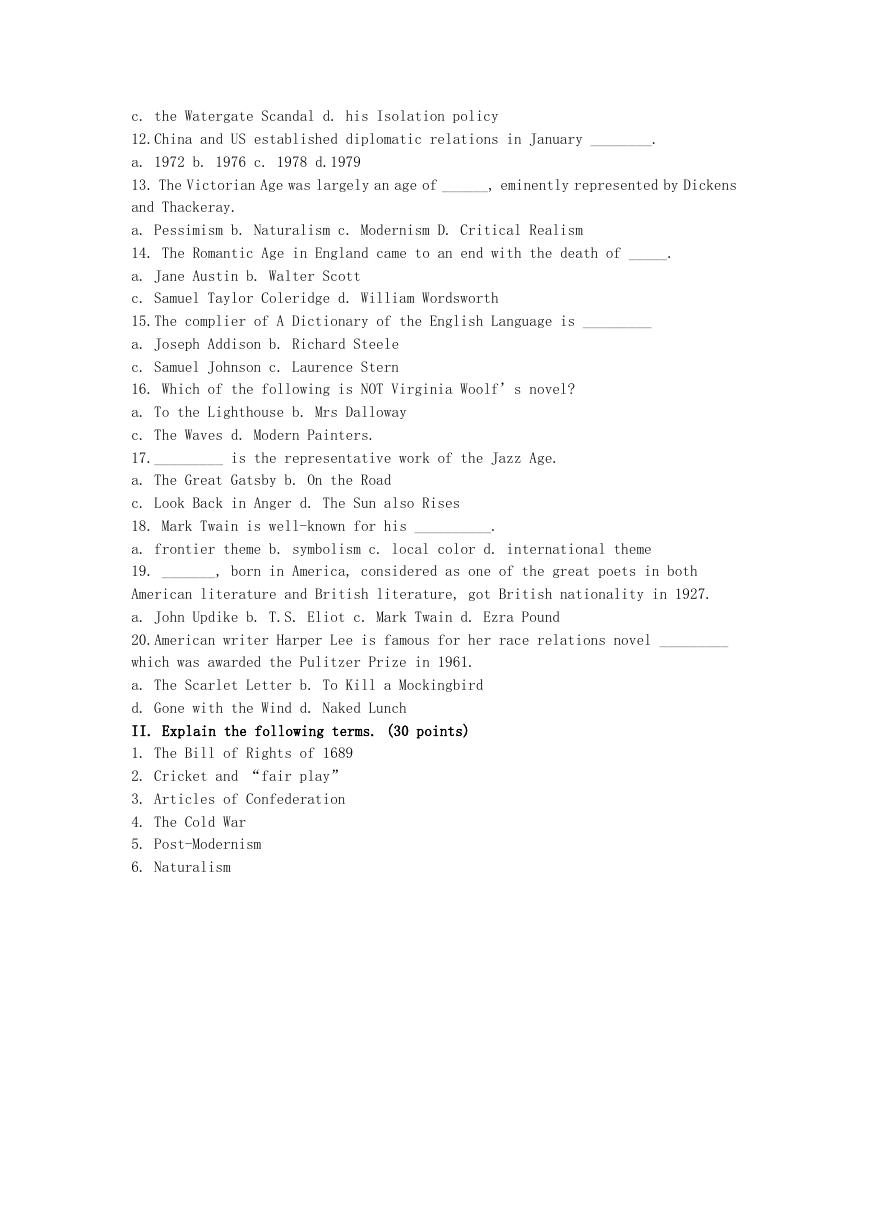2015 年山东青岛大学英语综合考研真题
Part One Linguistics (50 points)
I. Define the following terms briefly. (20 points)
1. suprasegmental
2. morpheme
3. inflection
4. immediate constituent analysis
5. deep structure
6. converse antonymy
7. cooperative principle
8. entailment
9. interlanguage
10. case grammar
II. Answer ONE of the two essay questions below with at least 300 words. (30 points)
1. How does Halliday relate the functions performed by language to its structures,
or systems?
2. Please give brief introductions to main branches of linguistics and give a
detailed description of one branch that you are interested in.
Part Two Translation (50 points)
I. Translate the following into Chinese. Your translation should both be an
intelligibly fluent representation of the original text. (25 points)
It is in the nature of things that the target text displays only the translator’
s final decisions. Readers perceive an end-product, a result of a decision-making
process; they do not have access to pathways leading to decisions, to the dilemmas
to be resolved by the translator.
What is available for scrutiny is the end-product, the result of translation practice
rather than the practice itself. In other words, we are looking at translation as
product instead of translating as process.
The distinction is an important one, as Widdowson points out. Bell suggests that
the tendency to ignore the process involved in the act of translating lies behind
the relative stagnation of translation studies in recent years. If we treat text
merely as a self-contained and self-generating entity, instead of as a
decision-making procedure and an instance of communication between language users,
our understanding of the nature of translating will be impaired.
II. Translate the following into English. Your translation should both be an
intelligibly fluent representation of the original text. (25 points)
我们以为所谓“直译”也者,带并非一定是“字对字”,一个 不多,一个也不少。因为中
西文字组织的不同,这种样“字对字” 一个不多一个也不少的翻译,在实际上是不可能的。
从前张崧年 先生译过一篇罗素的论文。张先生的译法真是“道地到廿四分” 的直译,每个
前置词,他都译了过来,然而他这篇译文是没人看 得懂的。当时张先生很坚持他的译法。
他自己也知道他的译文别 人看不懂,可是他对《新青年》的编者说:“这是一种试验。大家
�
看惯了后,也就懂得了!”当时《新青年》的编者陈促甫先生也不 赞成张先生此种“试验”,
老实不客气给他改,改了,张先生还是 非常不高兴。现在张先生大概已经抛弃了他的试验
了罢,我可不 十分明白,但是从这个故事就证明了“直译”的原则并不在“字 对字”一个
也不多,一个也不少。“直译”的意义就是“不要歪曲 了原作的面目”。倘使能够办到“字
对字”,不多也不少,自然是 理想的直译,否则,直译的要点不在此而在彼。
Part Three Culture (50 points)
I. Choose the answer that best completes the statement or answer the question. (20
points)
1. ________ brought the new religion, Christianity to Britain.
a. the Celts b. the Anglo-Saxons C. The Jutes D. The Romans
2. In its full sense, the British Parliament consists of __________.
a. the House of Lords and the House of Commons
b. the House and the Senate
c. the Queen and the House of Lords
d. the Sovereign, the House of Lords, and the House of Commons
3. Which of the following is NOT a national daily newspaper in the UK ?
a. Financial times b. The Guardian
c. The Times d . The Observer.
4. The Great Charter was signed by ________
a. King Henry I b, King William c. King John d. King Richard
5. For electoral purposes, Britain is divided into 651constituencies, each of
which returns _______ to the House of Commons.
a. one member b. two members c. three members d. four members
6. New Englanders were originally knows as ______, which come to stand for
all Americans.
a. Uncle Sam b. Quakers c. Puritans d. Yankees
7. The theme of Thanksgiving Day has always been ____________.
a. friendship and happiness b. peace and plenty, health and happiness
c. cooperation and rich reward d. love and happiness
8. The Bill of Rights introduced by James Madison is the term used for _____
to the Constitution of the United States.
a. the first ten amendments b. the last five amendments
c. the tenth amendments d. the most important amendment
9. The New Deal was advanced by President __________.
a. Franklin D. Roosevelt b. Theodore Roosevelt
c. William McKinley d. Thomas Woodrow Wilson
10. When the President of the US signs an act passed by Congress into law, it
still can be cancelled if ___________.
a. the lower federal court decides that it goes against the previous laws.
b. the Supreme Court decides that it goes against previous laws
c. the lower federal court decides it is unconstitutional
d. the Supreme Court decides it is unconstitutional.
11. Richard Nixon resigned in 1974 because of _________
a. the Great Depression b. the Black Power movement
�
c. the Watergate Scandal d. his Isolation policy
12.China and US established diplomatic relations in January ________.
a. 1972 b. 1976 c. 1978 d.1979
13. The Victorian Age was largely an age of ______, eminently represented by Dickens
and Thackeray.
a. Pessimism b. Naturalism c. Modernism D. Critical Realism
14. The Romantic Age in England came to an end with the death of _____.
a. Jane Austin b. Walter Scott
c. Samuel Taylor Coleridge d. William Wordsworth
15.The complier of A Dictionary of the English Language is _________
a. Joseph Addison b. Richard Steele
c. Samuel Johnson c. Laurence Stern
16. Which of the following is NOT Virginia Woolf’s novel?
a. To the Lighthouse b. Mrs Dalloway
c. The Waves d. Modern Painters.
17._________ is the representative work of the Jazz Age.
a. The Great Gatsby b. On the Road
c. Look Back in Anger d. The Sun also Rises
18. Mark Twain is well-known for his __________.
a. frontier theme b. symbolism c. local color d. international theme
19. _______, born in America, considered as one of the great poets in both
American literature and British literature, got British nationality in 1927.
a. John Updike b. T.S. Eliot c. Mark Twain d. Ezra Pound
20.American writer Harper Lee is famous for her race relations novel _________
which was awarded the Pulitzer Prize in 1961.
a. The Scarlet Letter b. To Kill a Mockingbird
d. Gone with the Wind d. Naked Lunch
II. Explain the following terms. (30 points)
1. The Bill of Rights of 1689
2. Cricket and “fair play”
3. Articles of Confederation
4. The Cold War
5. Post-Modernism
6. Naturalism
�






 2023年江西萍乡中考道德与法治真题及答案.doc
2023年江西萍乡中考道德与法治真题及答案.doc 2012年重庆南川中考生物真题及答案.doc
2012年重庆南川中考生物真题及答案.doc 2013年江西师范大学地理学综合及文艺理论基础考研真题.doc
2013年江西师范大学地理学综合及文艺理论基础考研真题.doc 2020年四川甘孜小升初语文真题及答案I卷.doc
2020年四川甘孜小升初语文真题及答案I卷.doc 2020年注册岩土工程师专业基础考试真题及答案.doc
2020年注册岩土工程师专业基础考试真题及答案.doc 2023-2024学年福建省厦门市九年级上学期数学月考试题及答案.doc
2023-2024学年福建省厦门市九年级上学期数学月考试题及答案.doc 2021-2022学年辽宁省沈阳市大东区九年级上学期语文期末试题及答案.doc
2021-2022学年辽宁省沈阳市大东区九年级上学期语文期末试题及答案.doc 2022-2023学年北京东城区初三第一学期物理期末试卷及答案.doc
2022-2023学年北京东城区初三第一学期物理期末试卷及答案.doc 2018上半年江西教师资格初中地理学科知识与教学能力真题及答案.doc
2018上半年江西教师资格初中地理学科知识与教学能力真题及答案.doc 2012年河北国家公务员申论考试真题及答案-省级.doc
2012年河北国家公务员申论考试真题及答案-省级.doc 2020-2021学年江苏省扬州市江都区邵樊片九年级上学期数学第一次质量检测试题及答案.doc
2020-2021学年江苏省扬州市江都区邵樊片九年级上学期数学第一次质量检测试题及答案.doc 2022下半年黑龙江教师资格证中学综合素质真题及答案.doc
2022下半年黑龙江教师资格证中学综合素质真题及答案.doc